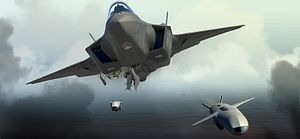The Japan Self Defense Force (JSDF) is considering arming fighter jets with long-range air-to-ground missiles to strike North Korean missile sites in the event of war, Reuters reported earlier this week.
According to two sources, Japan will purportedly allocate funds to study the feasibility of arming its fleet of Mitsubishi F-15J all-weather air superiority fighters with long-range missiles capable of destroying ground targets in North Korea.
“There is a global trend for using longer range missiles and it is only natural that Japan would want to consider them,” one of the sources told Reuters. However, new long-range missiles will not be included in next year’s defense budget and the Japanese government is unlikely to greenlight purchasing offensive weapon systems any time soon.
Japan has repeatedly denied publicly that it intends to acquire an offensive strike capability.
“We are not currently looking at funding for this,” Japanese Defense Minister Itsunori Onodera said on December 5. “We rely on the United States to strike enemy bases and are not looking at making any changes to how we share our roles.”
The JSDF currently operates missiles with ranges of less than 300 kilometers (186 miles).
The debate over the development of long-range strike capabilities has periodically flared up over the past decade and recently intensified given the growing sophistication of North Korea’s ballistic missile and weapons of mass destruction programs.
Influential Japanese lawmakers have pushed for the procurement of new missile systems on numerous occasions this year.
Possible candidates include the U.S.-made Joint Air to Surface Standoff Missile Extended-Range (JASSM-ER), capable of hitting targets at a distance of up to 1,000 kilometers (620 miles), and the next-generation, long-range, precision-guided Joint Strike Missile (JSM), with an estimated range of around 500 kilometers (310 miles).
“The JSM, co-developed by U.S. defense contractor Raytheon and Norwegian defense company Kongsberg Gruppen, is a fifth-generation cruise missile specifically designed to fit inside the F-35A’s weapons bay to maintain the aircraft’s stealth capabilities,” I explained previously. The JSM has been under development since 2008 and is expected to become operational in 2025.
The JSDF is in the process of inducting 42 F-35A stealth fighters through the U.S. Foreign Military Sales Program and might place a follow-on order for additional F-35A fighter jets in the near future.
Cheaper options could include truck-launched surface-to-surface missiles.
“Japan has considered a number of options, including the U.S.-made Tomahawk long-range subsonic cruise missile,” I reported in March. “Deployed on Atago-class or Kongo-class of guided missile destroyers (or aboard Soryu-class diesel-electric attack submarines), the sea-based and mobile Tomahawk missile could provide a visible deterrent.”
































